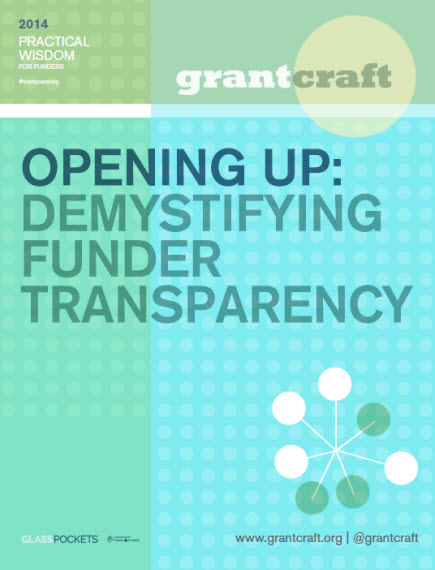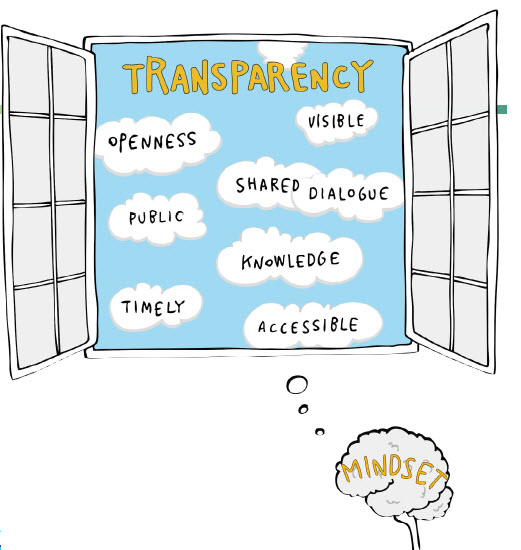
Opening Up: Demystifying Funder Transparency is a new GrantCraft guide released in collaboration with Glasspockets from the Foundation Center. The report explores how transparency can strengthen credibility, improve grantee relationships, facilitate greater collaboration, increase public trust, reduce duplication of effort, and build communities of shared learning. This very practical report which includes an infographic summarizing research conducted on Foundation’s transparency practices and links to podcasts is intended to help funders work in a more open way.

The report begins with a simple, holistic definition of transparency and why it is important for funders to be transparent:
“Transparency is, in a word, openness. A foundation that operates transparently is one that shares what it does, how it does it, and the difference thatit makes in a frank, easily accessible, and timelyway. True transparency comes down to a mindset,one in which funders believe they are most effective when they approach all aspects of their work by saying “let’s publicly share this. But transparency is not just about sharing information and processes. It is also a means to greater accountability, and to building relationships between a foundation and other key groups such as grantees, applicants, partners, and other funders.”
The guide identifies on the key benefits of transparency as reported by the funders interviewed for the guide:
- Foundations profiled in this guide and those who responded to a 2013 GrantCraft survey listed the following benefits of transparency:
- Less time spent explaining goals and strategies to potential grantees
- Better, more on-target grant proposals
- More effective and informed grantmaking based on feedback from grantees and other stakeholders
- Stronger and more open relationships with grantees and other nonprofit organizations
- Closer relationships with other foundations,leading to more collaborative grantmaking
- Increased public trust
The guide offers five chapters that include practical tips and recommendations for Foundations to become more transparent. These sections are different pathways towards becoming more open and are summarized in this nifty infographic:
- Behind Closed Doors: Sharing Grantee Selection Processes and Grantee Data
- Is the Needle Moving? Sharing Performance Assessments
- Improving Relationships: Strengthening Engagement With Grantees and Other Stakeholders
- Peers Helping Peers: Improving the Practice of Philanthropy
- Communicating Well: Connecting Using Every Opportunity
Each chapter is packed with examples from large and small foundations, tips, and small worksheets. My favorite section is the last chapter about communications. It has several excellent case studies from the Meyer Memorial Trust, Robert Wood Johnson Foundation and the Packard Foundation. These case studies share examples of how a transparent funder’s web site should be design and the content strategy; allowing staff to communicate with a personal voice; and opening up the conversation about funding strategy development. The chapter provides excellent “baby steps” for funders to start down the path of transparency in communications.
This does not come without challenges as identified in the guide:
- Social media can be seen as an easy way to be transparent, but if foundations use it only as a one-way broadcast mechanism, they are not taking full advantage of its ability to engage with others in dialogue and conversation.
- Communicating through social media does not work as well if done in a highly centralized“foundation voice,” as is observed often in traditional forms of communication, because it runs counter to purpose of these avenues, which encourage a more informal, interactive, and human voice.
- Mediums that allow for public comment and dialogue require people to make themselves vulnerable. The nature of these mediums removes a wall between the content author and others,which can create open channels for criticism.
- Simply making information or a commenting function available does not mean that people want it.
This guide is useful to both large and small foundations and can help them taking steps to become more transparent that increases their effectiveness and makes them more responsive to stakeholders. This guide is embraced by foundation can help make the funder make the shift from a culture of “everything is closed” to to mindset of sharing everything unless a good reason exists not to. And once a foundation takes these steps and want to measure the benefits, here are a few tips.
How does your organization embrace transparency? What are the benefits?
